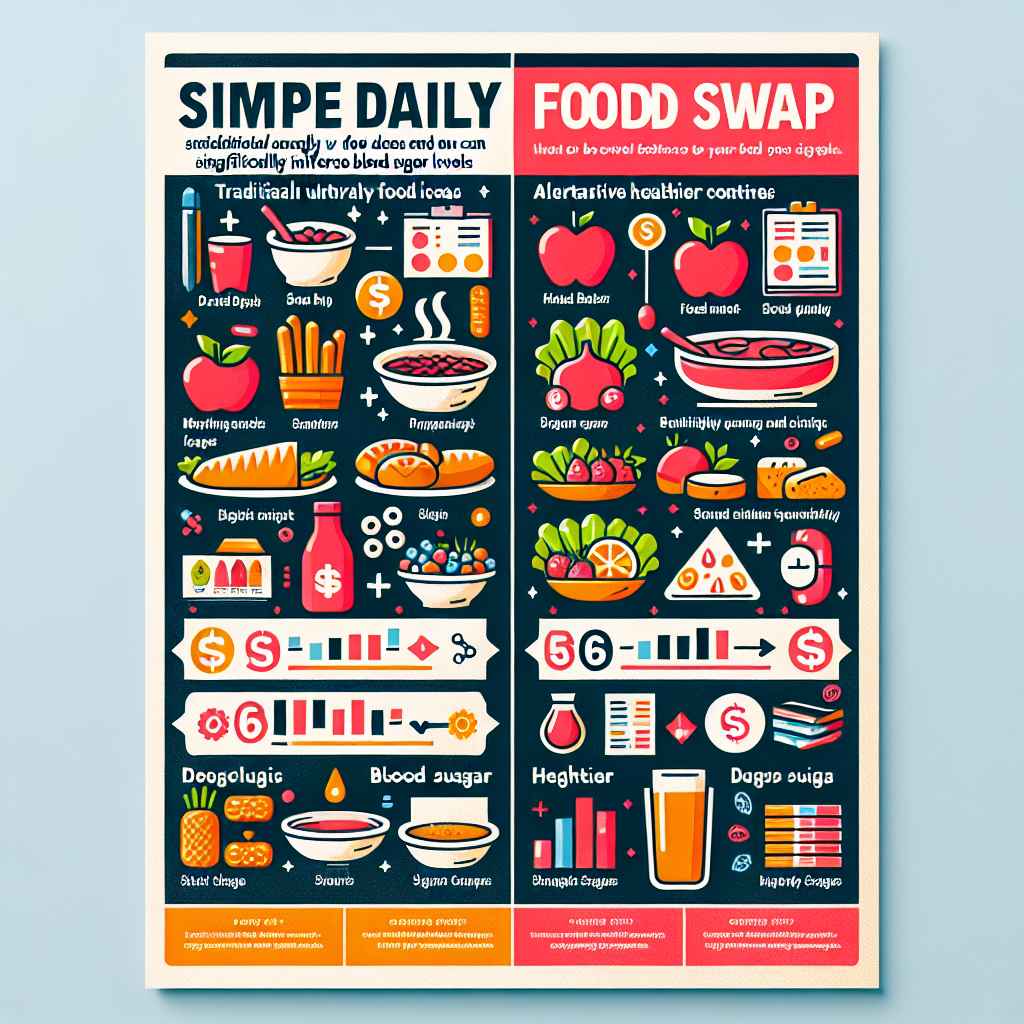Simple Daily Food Changes to Control Blood Sugar
1. Introduction to Blood Sugar Management
Maintaining stable blood sugar levels is crucial for overall health, particularly for those living with diabetes or prediabetes. According to the Centers for Disease Control and Prevention (CDC), approximately 34.2 million Americans have diabetes, while 88 million adults have prediabetes. Managing blood sugar can be influenced significantly by dietary choices. This blog discusses daily food swaps that can help control blood sugar levels efficiently.
2. Say Goodbye to White Bread
White bread is a staple in many diets but can lead to rapid spikes in blood sugar due to its high glycemic index. Choose for whole-grain or sprouted grain bread instead. Whole grains like oats and brown rice take longer to digest, resulting in a steadier blood sugar response. Studies show that whole grains may reduce the risk of Type 2 diabetes by 32%.
3. Replace Sugary Breakfast Cereals
Many breakfast cereals are loaded with sugars and refined carbohydrates that can elevate blood sugar levels. Instead, select oatmeal or whole-grain cereals without added sugars. For example, a cup of oatmeal has only about 1 gram of sugar compared to many cereals that can have over 10 grams. Add nuts or seeds for a nutrient-dense breakfast that is rich in fiber.
4. Swap Out Regular Soda for Sparkling Water
Regular sodas are high in sugar, with one can containing up to 39 grams. Instead, switch to sparkling water or flavored seltzers that contain no sugar or calories. This swap can reduce daily sugar intake dramatically. Furthermore, studies indicate that sugary drinks significantly increase the risk of developing Type 2 diabetes, making this swap an essential step for those looking to manage their blood sugar levels.
5. Choose Fruit Over Fruit Juice
While fruit juice may seem healthy, it often contains added sugars and lacks the fiber present in whole fruits. For instance, an 8-ounce glass of orange juice can contain around 21 grams of sugar, while a medium orange contains about 12 grams along with essential fiber. Eating whole fruits not only stabilizes blood sugar but also provides important vitamins and minerals.
6. Choose for Healthy Fats Instead of Trans Fats
Many processed snacks contain trans fats, which can lead to insulin resistance, a major factor in diabetes. Replace these snacks with healthy fats found in avocados, nuts, and olive oil. A diet rich in healthy fats can improve insulin sensitivity and even aid in maintaining a healthy weight—both crucial for blood sugar management.
7. Rethink Your Snack Choices
Chips and pretzels may be popular snack options, but they are typically made from refined grains and provide little nutritional value. Instead, choose snacks like carrot sticks with hummus or Greek yogurt with berries. Carrots have a low glycemic index and are rich in fiber, while yogurt provides protein and probiotics that support a healthy gut.
8. Switch to Low-Fat Dairy
Dairy products can be a part of a balanced diet, but full-fat dairy can often be high in saturated fats, which can negatively impact blood sugar management. Substitute regular milk, cheese, and yogurt for their low-fat or non-fat counterparts. For example, a cup of whole milk has about 8 grams of saturated fat compared to just 2.5 grams in low-fat milk. This simple swap can contribute to better weight management and overall metabolic health.
9. Choose Lean Proteins Over Red Meats
Red and processed meats are associated with higher insulin resistance, resulting in increased blood sugar levels. Instead, opt for lean protein sources like chicken, turkey, or plant-based proteins such as lentils and chickpeas. A study published in the American Journal of Clinical Nutrition indicated that higher consumption of lean protein could help maintain stable blood glucose levels.
10. Incorporate More Fiber
Adding fiber to meals is an effective way to manage blood sugar. Fiber slows down the absorption of sugars, leading to more stable blood sugar levels. Swap out low-fiber foods with high-fiber options like beans, whole grains, and vegetables. For instance, one cup of cooked lentils contains about 15.6 grams of fiber, which can significantly aid in blood sugar control.
11. Be Mindful of Portion Sizes
Even healthy foods can impact blood sugar levels if consumed in excessive amounts. Being mindful of portion sizes is crucial. Familiarize yourself with recommended serving sizes—like one cup of vegetables or half a cup of grains. Using smaller plates can also create an illusion of larger servings while keeping portion sizes in check.
12. Conclusion: The Power of Small Changes
Integrating small food swaps into your daily routine can lead to significant improvements in blood sugar management over time. With approximately 90-95% of diabetes cases being Type 2, making these changes can not only prevent this condition but also promote better overall health. Remember, moderation is key, and it’s wise to consult with a healthcare provider or a registered dietitian to personalize any dietary changes you plan to implement. Your journey to better blood sugar control can start with just one small step today.




Post Comment